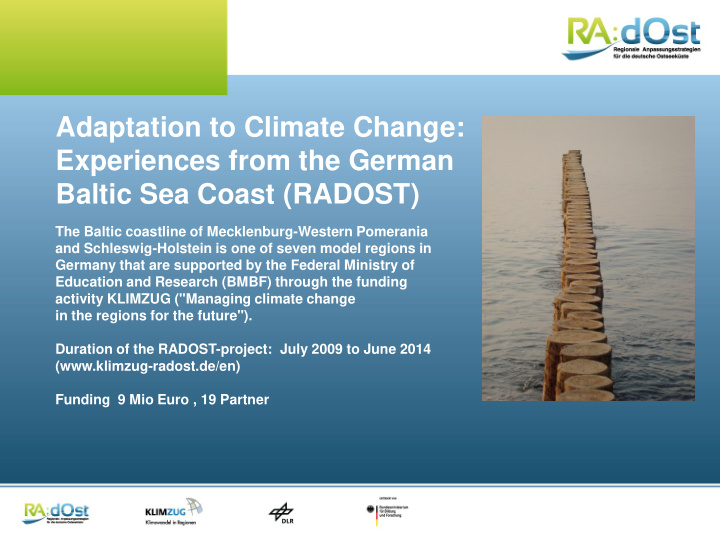



Adaptation to Climate Change: Experiences from the German Baltic Sea Coast (RADOST) The Baltic coastline of Mecklenburg-Western Pomerania and Schleswig-Holstein is one of seven model regions in Germany that are supported by the Federal Ministry of Education and Research (BMBF) through the funding activity KLIMZUG ("Managing climate change in the regions for the future"). Duration of the RADOST-project: July 2009 to June 2014 (www.klimzug-radost.de/en) Funding 9 Mio Euro , 19 Partner
Content I Background and objectives: RADOST- project II Why an international exchange between the Baltic Sea and the Chesapeake Bay? III Next steps
Geographic Areas Denmark Bay of Kiel Adlergrund Lubmin Darss Schlei Rostock Trave Bay of Themes: Lübeck Coastal Protection Warnow Poland Tourism/Beach Management Peene Water Management/ Agriculture Oder Estuaries Ports/ Maritime Economy Nature Conservation/ LandUse Renewable Energies Oder
Problems Facing the German Baltic Sea Region -Sea level rise -Storm surge heights -Coastal erosion -Increased wind speeds -Saline intrusion in water tables -Alteration in water quality -Loss in species/ invasive species Source: Hans von Storch, HZG Medium and long-term threat to coastal communities and cities
Coastal Erosionen After Extreme Events Source: Bay of Kiel Alliance
Water and Beach Quality Source: www.crackajack.de/.../uploads/ 2008/03/1-11.jpg Source: M. Mossbauer Source: G. Niedzwiedz
Guiding adaptation action at the German Baltic Sea Coast Goal of RADOST: To support planners, decision makers, Adaptation is described as a ‚Process of Dialogue‘ communities in dealing with (Lonsdale et al2009:22). A wide range of the challenges of adapting to stakeholders are needed to provide integrated, climate change by linked-up solutions to climate/environmental - Awareness raising and problems. involvement in understanding Municipalities, regional (even national) government the problem; departments, transport authorities, utilities (energy - Providing good practice and water), conservation groups, health officials, examples; businesses, emergency services, climate, social, - Guiding to financial ecological and economic researchers and others. resources; - Supporting network building;
Geo-morphological similarities Die Chesapeake Bay: The little sister of the Baltic See….
„Ask the Audience“: Regional Workshops at the East Coast of the U.S.
Personal exchange between coastal stakeholders: Workshops in Maryland (Annapolis) and Schleswig-Holstein (Timmendorf Beach)
List of guiding principles for good adaptation Source: ETC/ACC Technical Paper 2010/6 November 2010, A. Prutsch, T. Grothmann, I. Schauser, S. Otto, S. McCallum.
Adaptation to Climate Change: Experiences from the German Baltic Sea Coast (RADOST) www.klimzug-radost.de/en grit.martinez@ecologic.eu
Recommend
More recommend